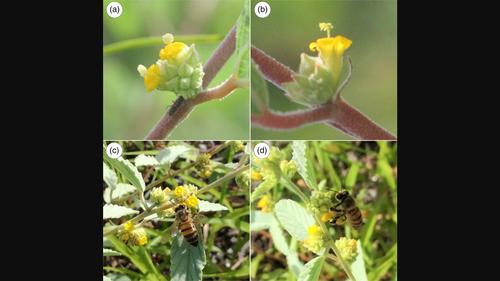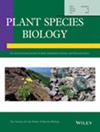二瓣花热带灌木圆叶石斛的花型多态性及异型不亲和性
IF 1.3
4区 生物学
Q4 ECOLOGY
引用次数: 0
摘要
摘要:Waltheria属以具有高比例的二瓣植物而闻名(约85%)。然而,仅在少数Waltheria物种中对diyly进行了全面研究。考虑到当今自然生态系统中外来传粉媒介的存在,它们可能会影响花形态之间的合法花粉传递,对didily的研究具有特殊的生态学意义。本文研究了热带灌木圆叶Waltheria rotundifolia花型间的性别互易性,考察了花粉传递模式是否符合适当的分布规律,并对其不亲和系统进行了研究。互易性是通过测量性性状来表征的,而花粉性状是通过测量辅助多态性来评价的。通过对圆形叶的主要访花者蜜蜂柱头和体上的花粉量进行定量分析,确定了白菊花促进花粉合法传递的效率。最后,通过手传粉来确定不亲和系统的强度。花表现出性器官和花粉的相互排列,这是二花科植物的典型特征。我们观察到花粉在蜜蜂身体上的不同位置。然而,花粉负荷和合法花粉沉积在柱头上的形态间差异表明蜜蜂的花粉转移效率不高。手传粉揭示了异型不亲和系统的存在。总体而言,我们的研究结果表明,尽管在研究群体中存在花粉不对称传递的因素,但圆叶菊的花粉沉积不对称可能与蜜蜂的觅食行为有关。本文章由计算机程序翻译,如有差异,请以英文原文为准。

Floral polymorphism and heteromorphic incompatibility in the distylous tropical shrub Waltheria rotundifolia (Malvaceae )
Abstract The genus Waltheria is known for having a high percentage of distylous species (ca. 85%). However, distyly has only been comprehensively studied in a few Waltheria species. The study of distyly is of particular ecological relevance given the occurrence of exotic pollinators in natural ecosystems nowadays, which could potentially affect legitimate pollen transfer between floral morphs. In the present study, we characterized the sexual reciprocity between floral morphs in the tropical shrub Waltheria rotundifolia , we tested if the pollen transfer patterns were in accordance with proper distyly, and we tested its incompatibility system. Reciprocity was characterized by measuring sexual traits, while pollen traits were measured to evaluate the presence of ancillary polymorphisms. The efficiency of distyly to promote legitimate pollen transfer was determined by quantifying pollen loads deposited on stigmas and on the body of Apis mellifera , the main floral visitor of W. rotundifolia . Finally, hand pollinations were performed to determine the strength of the incompatibility system. Flowers exhibit a reciprocal arrangement of sexual organs and pollen ancillary features typical of distylous plants. We observed a differential placement of pollen on the body of A. mellifera . However, intermorph differences in the pollen loads and legitimate pollen deposited on stigmas suggest inefficient pollen transfer by A. mellifera . Hand pollinations revealed the presence of a heteromorphic incompatibility system. Overall, our results show that although factors for disassortative pollen transfer are present in the studied population, W. rotundifolia exhibits asymmetric pollen deposition probably due to A. mellifera foraging behavior.
求助全文
通过发布文献求助,成功后即可免费获取论文全文。
去求助
来源期刊

Plant Species Biology
生物-生态学
CiteScore
2.70
自引率
14.30%
发文量
36
审稿时长
>12 weeks
期刊介绍:
Plant Species Biology is published four times a year by The Society for the Study of Species Biology. Plant Species Biology publishes research manuscripts in the fields of population biology, pollination biology, evolutionary ecology, biosystematics, co-evolution, and any other related fields in biology. In addition to full length papers, the journal also includes short research papers as notes and comments. Invited articles may be accepted or occasion at the request of the Editorial Board. Manuscripts should contain new results of empirical and/or theoretical investigations concerning facts, processes, mechanisms or concepts of evolutionary as well as biological phenomena. Papers that are purely descriptive are not suitable for this journal. Notes & comments of the following contents will not be accepted for publication: Development of DNA markers. The journal is introducing ''Life history monographs of Japanese plant species''. The journal is dedicated to minimizing the time between submission, review and publication and to providing a high quality forum for original research in Plant Species Biology.
 求助内容:
求助内容: 应助结果提醒方式:
应助结果提醒方式:


